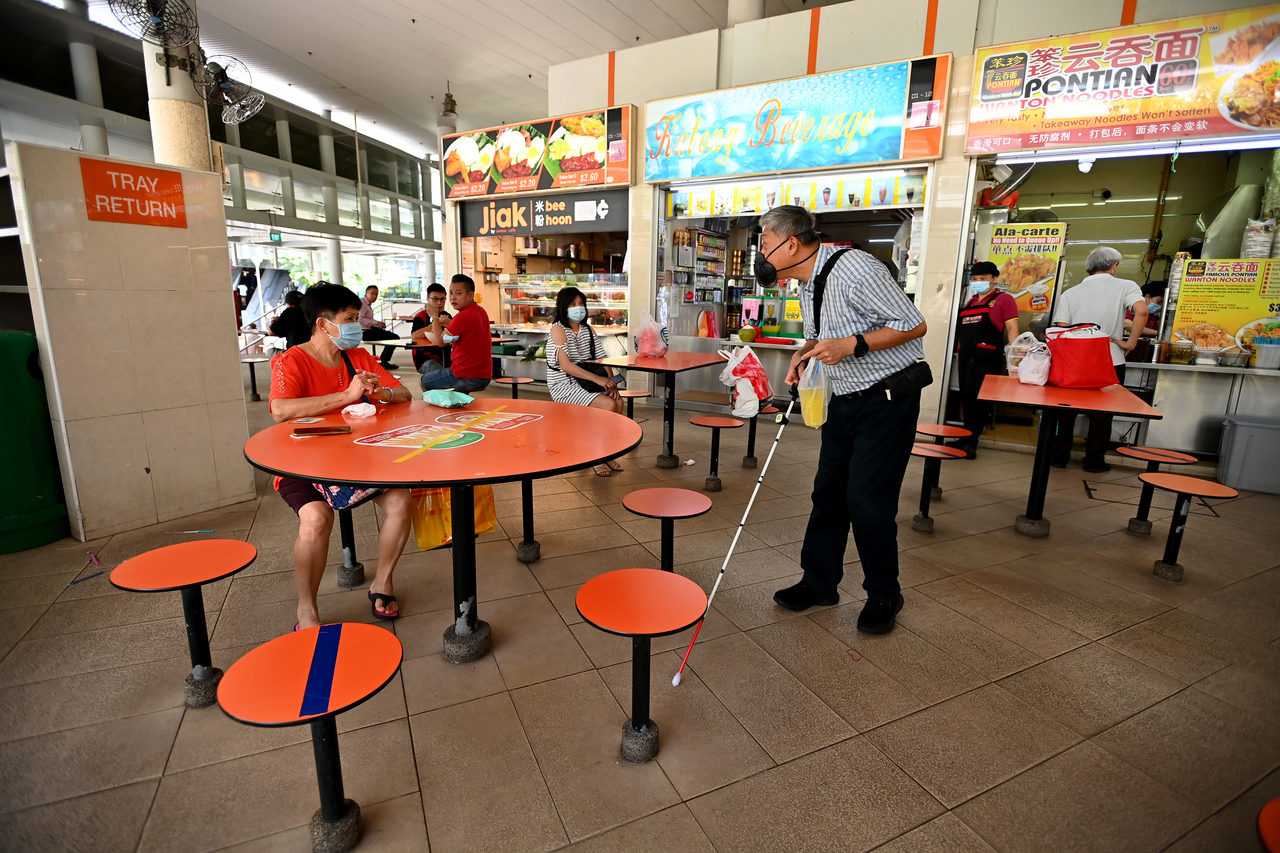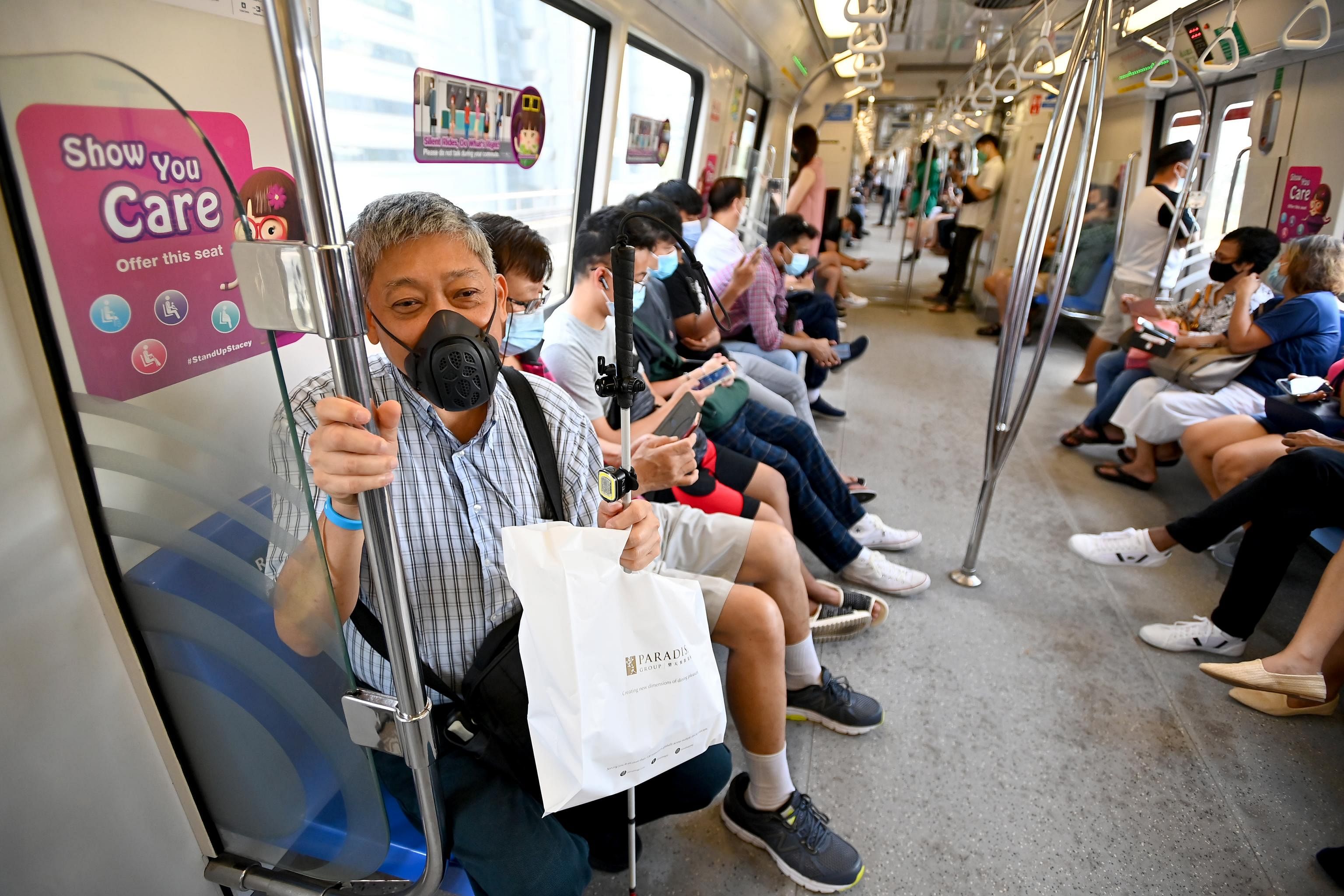Which seats are marked for safe distancing? Covid-19 challenges the visually impaired in S'pore face
Sign up now: Get ST's newsletters delivered to your inbox

Mr Dennis Teo is unable to make out which seats have been marked for safe distancing at the hawker centre.
ST PHOTO: LIM YAOHUI
Follow topic:
SINGAPORE - Navigating Covid-19 measures and restrictions has been challenging for people like Mr Dennis Teo, who is visually impaired.
The 60-year-old, who lives with his wife and two sons in Geylang, visits the hawker centres near his home at least twice a week for lunch. The retired information technology manager said he is unable to make out which seats have been marked for safe distancing.
"I can feel the tape or netting when I sweep the chair with my hands, but it's hard to tell when the marker is less obvious," he said.
"Luckily, people do help when they see me struggling, though some have told me off before for being in the wrong seat."
Mr Teo is blind in his right eye and sees only shapes and shadows in the other. He lost his sight at age 53 after being severely dehydrated from a bad bout of food poisoning.
He is able to travel independently using a white cane and navigation apps on his phone equipped with voice prompts. "It's liberating to go out on my own, even if I need help from people sometimes to tell me when my bus is here, or how to get to a specific unit in a building."
But since the pandemic started, getting around Singapore has been hard as he has had trouble finding the SafeEntry QR code or Gateway device to scan with the TraceTogether app on his phone to check in.
"I have to move my phone around to find it or go very close to the device to see it," he said.
"But it's not so bad once I save the location to 'Favourites' on the TraceTogether app as I can check in from there without scanning."
For 32-year-old receptionist Patricia Poo, who is partially blind, it is the closure of some entrances and exits at shopping centres as part of crowd control measures that have proven disorienting.
"I have a mind map of the places I'm familiar with. But when certain areas are blocked off, I can't rely on walking memory and need to figure out a new route," said Ms Poo, who has congenital sclerocornea, a rare genetic condition in which the cornea is opaque instead of clear.
She recalls getting lost in Dhoby Ghaut MRT station last year as one of the exits linking it to Plaza Singapura was closed. With help from a stranger, she found her way to the mall situated above the station.
The Singapore Association of the Visually Handicapped (SAVH) said it is "very aware" of the challenges that people with visual impairment face amid the pandemic, especially those who travel alone.

Mr Teo is able to travel independently using a white cane and navigation apps on his phone equipped with voice prompts.
PHOTO: ST FILE

It provides training in orientation and mobility to clients on request, to help them navigate new routes when certain areas are closed off. "The situation is more manageable when the visually impaired are with caregivers and, to some extent, when there are helpful SafeEntry personnel or members of the public," SAVH said.
It added that the Government has issued guidelines for safe management enforcement personnel to exercise flexibility when it comes to people with disabilities.
According to the population census released in June, there were 20,000 visually impaired people aged five and above here last year, making up about 0.5 per cent of the population.
The measures introduced to curb Covid-19 infections have been hard for them.
Take Mr Ng Choon Hwee, who is completely blind and unable to gauge how far he is standing from others in a queue.
"I can't see the stickers on the ground that remind people to keep a distance (from one another)," said the 66-year-old, who works at a church where he helps people with visual impairment.
With safe distancing rules in place, people are more hesitant to offer their elbows to guide those with visual impairment. Instead, some members of the public prefer using just verbal instructions.
"It's understandable that people are being more cautious in this climate, but many of them do empathise (with our struggles) and help us," said Mr Muhammad Hidayat Mohamad Yaakob, who became completely blind in his late teens after a football accident.
Like the rest who spoke to The Straits Times, Mr Hidayat is fully vaccinated.
"When they offer assistance, I bear in mind not to have skin-on-skin contact with them by holding on to their sleeve or collar," said the 32-year-old, who is a guide at Dialogue in the Dark Singapore, an exhibition in Ngee Ann Polytechnic where visitors experience daily situations in total darkness.
He said he is also worried that his TraceTogether token may run out of battery. "I prefer to use the token as it is more convenient than the app. But sometimes when I try to check in, there's no beep and only then do I realise that the battery has run out," he said.
In response to queries, a spokesman for the Government Technology Agency said the TraceTogether programme had to be put in place in a very short time, in response to the public health situation. "Even so, the engineers paid close attention to making the design inclusive and accessible, so that all segments of the population may be protected by digital contact tracing."
He added: "As with any engineering product, we invariably have to make design trade-offs. The TraceTogether tokens were designed to minimise power consumption so that batteries will last longer. Hence, only an LED was incorporated into the token as a visual indicator of battery status."
Dr Marissa Medjeral-Mills, executive director of the Disabled People's Association, said the Government can consider standardising the layout of SafeEntry checkpoints as well as the location of QR codes, like placing them on the right side of the entrance of shops.
"Shopping centres can assist by making information about entrances and exits available on their website, social media platforms and customer service hotlines. Their staff can also be trained on how to best assist people with visual impairments and other disabilities," she said.

